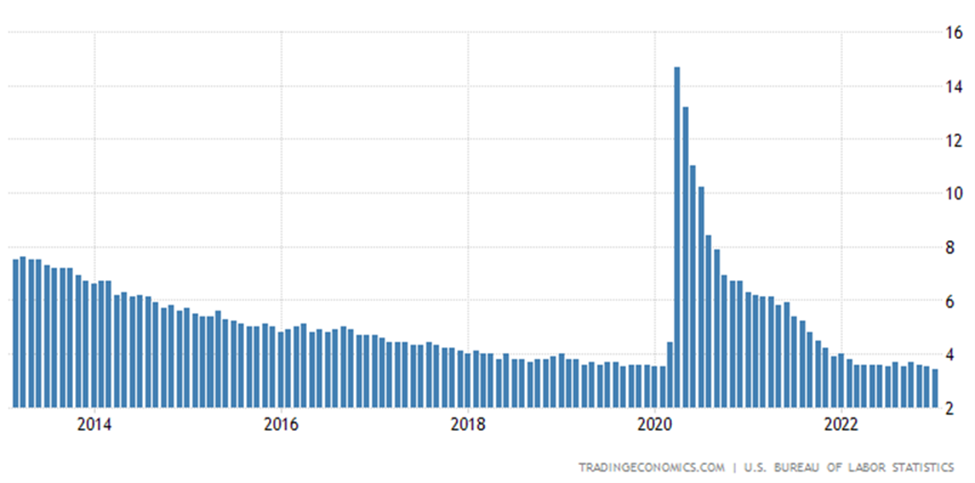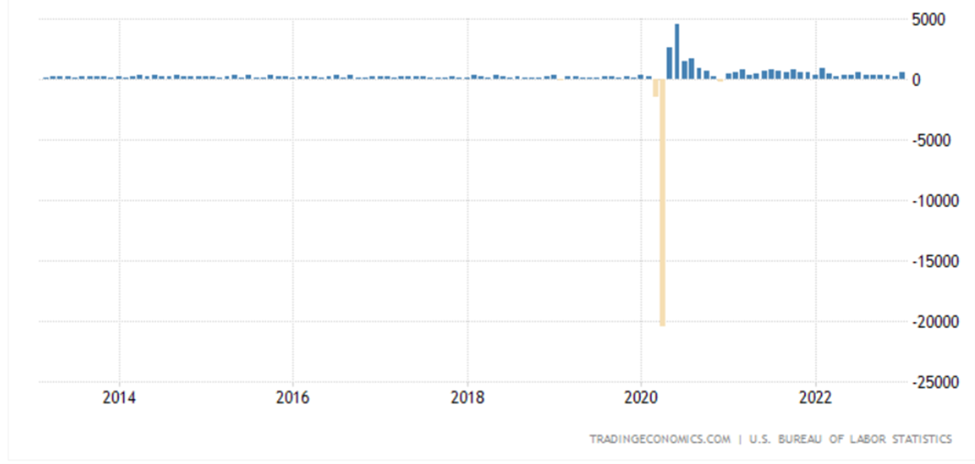Unemployment Rate and Nonfarm Payrolls: Why They Are So Important for the Markets
On the first Friday of every month, the US Department of Labor releases data on the employment rate and the number of people employed in non-agricultural sectors of the economy. Why is it so important?
First, high unemployment leads to social tensions, promoting the rise to power of radical politicians, and eventually potentially leading to unrest and a violent takeover of power.
Second, it is the effect of unemployment on production and, consequently, on economic growth (GDP growth).
Third, unemployment reduces the flow of taxes into the budget and increases government spending, including such things as unemployment benefits and social security payments.
In the United States, the unemployment rate is calculated with the number of people employed on nonfarm payrolls. This article will discuss how this calculation is done and what you must look for to analyze the unemployment rate.
The US unemployment rate
The unemployment rate is calculated through surveys of about 60,000 families by the Ministry of Labor. Both agricultural and nonagricultural workers are interviewed. A calculation is then made using the following simple formula:

Economists agree that a normal unemployment rate is 4-5%. Since the end of the mortgage crisis, the unemployment rate in the US has continued to fall, and reached its historic low in February 2023 (3.4%).

We should remember that the US Department of Labor only counts people actively looking for work as unemployed. People who cannot change their situation are not counted in the unemployment rate.
Nonfarm Payrolls
Nonfarm Payrolls (NFP) are also calculated through surveys. This time, however, 440,000 companies with more than 50 million workers are being surveyed. Thus, this metric measures by how much the number of people employed in companies increased or decreased.
What number of NFPs is considered "normal"? The general idea is the more, the better. More labor means stronger economic growth, which often leads to higher inflation. According to various estimates by economists, with normal development of the American economy (3-4% per year), the number of jobs created should be at least 150,000 per month.
If you pay attention to the NFP figure, you can see how badly the crisis years have affected employment results (the figure was negative).

What else is published along with the unemployment rate and NFP?
The US economy is very complex and rich in different statistics. Along with the unemployment rate and nonfarm payrolls, several other indicators should be paid attention to.
Leaving aside the calculation of different NFP indicators for other groups (e.g., NFP for government workers and NFP for the private sector), the most relevant indicators are average hourly earnings, average workweek, and the percentage of the economically active population.
The growth of average hourly earnings leads to an increase in consumer spending, which increases consumption and consequently, economic growth. Therefore, this indicator can significantly impact the market situation.
As the name implies, the Average Workweek measures how many hours workers work during a week on average. An increase in the average workweek is considered an indicator of economic growth, while a decline is likely to lead to corporate layoffs.
The share of the economically active population reflects the number of people who have or wish to have a source of livelihood. These are people between the ages of about 15 and 70, who may be both employed and unemployed.
Consequently, the growth of the economically active population is, of course, good for the economy.
What should I look for to determine the reliability of the NFP and unemployment forecast?
Even before the Unemployment Rate and Nonfarm Payrolls are released, a block of unemployment statistics is released in the US, affecting the consensus forecast. This article will explain what we need to pay attention to in order to understand if the consensus forecast is reasonable.
Number of initial jobless claims and number of secondary jobless claims (released every Thursday; data collected weekly)
Estimate: the higher the number of applications for unemployment benefits, the worse the employment situation is. Consequently, if the number of monthly applications increases, we should hardly expect a positive unemployment rate.
Challenger, Gray&Christmas Job cuts
Estimate: the more people are cut, the higher the unemployment rate. The connection is quite apparent. Unfortunately, however, it is tough to assess what number of people to be cut is normal and what number is above the norm. We suggest keeping an eye on the surge indicator. If there is a significant number of redundancies, we can say that the unemployment rate is unlikely to go down.
Conference Board Job Index
Estimate: the higher the index of job announcements, the lower the unemployment rate. It seems logical to track the indicator in dynamics. The fact is that the growth of the vacancy rate is not immediately reflected in the unemployment rate. The interview and hiring procedures take some time (one or two months).
ADP Nonfarm payrolls
Estimate: this is one of the most controversial indicators, which raises many questions. Before the nonfarm payroll figure is released, a preliminary assessment from Automatic Data Processing Inc. (ADP) is released the day before publication (Wednesday). The report is generated by evaluating about 340,000 companies and 21 million workers. Unfortunately, the data from the ADP report and the US Department of Labor often do not match up.
Conclusion
Knowing how to forecast Nonfarm Payrolls numbers will give you a powerful tool in your market analysis.
Try to trade on Nonfarm payrolls release with FBS.